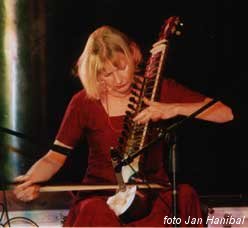Indian classical music - esraj solo
Elena Kubickova – esraj

E. K. studied classical violin under Gita Morenova, professor of the Prague Conservatory, after which she was a member of a string chamber orchestra for several years. She was educated in northern Indian classical music by violinist and musicologist prof. Dr. Smarajit Chakravorty, in India she studied under Dr. Jibendra Narayan Goswami (sitar maestro) and Dr. V. Balaji (singer and violinist, prof. of Hindu University in Benares). She has played the esraj since 1990. Together with other musicians she released several CDs of which several have been used as film music, for example for the three-part film by Igor Chaun "A Passage to India". She takes part in various festivals, e.g. Boskovice, Frýdek Místek, Lipnice, Alternativa (Theatre Archa), Febiofest (International film festival, Prague), One World (International documentary film festival, Prague) and has performed in Prague in a programme by the classical guitarist Lubomír Brabec at the Spanish synagogue. She has also appeared in Poland and Italy (International music Festival in Ferrara 2004). She collaborates with an important Czech tabla player Tomáš Reindl, Edward Powell, a Canadian sitar player living in Czech Republic and other musicians. The biggest honour for her is the collaboration with Dr. J. N. Goswami, with whom and his Indian tablaist she performed Jugalbandi in Prague (2005, 2006) and at the International Opera Festival Smetanova Litomysl in 2006. She regularly gives concerts of northern Indian classical music in many places of the Czech Republic. Elena also takes part in joint music-and-dance project DAMARU launched by Ivana Hessová, dancer and instructor of classical Indian dance kathak. For several years she has been preparing regular night programs of Indian classical music on the Czech National Radio Station "Vltava".
Esraj is a traditional Indian string instrument. It has 19 strings consisting of 4 main strings. The rest is formed into two octaves of resonant strings tuned into given gamut.
Tabla is a set of two drums. The drum on the right side is called dayan and is tuned in the key tonic. The left-side drum is called bayan and is tuned into bass.
Indian classical music is bound by the melodic system of Ragas and rhythmic system of Talas. A Raga is a specific melodic unit based on one of many Indian scales and determined by the notes used, their ascending and descending sequences, hierarchy of importance, association with a time of the day or night and emotions. E. Kubidkova is presenting Ragas of the Norht Indian branche of Indian classical music. The performance of a Raga consists of the slow opening part called the Alap, played by the soloist, which is followed by composed and imrovised parts of the Gat, organised to fit into a particular Tal, played by a tabla player. The musicians play usually two Gats in various tempi, they must understand both Raga and Tala thoroughly and obey their constraints to create the improvisations.

